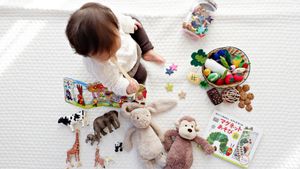YOGYAKARTA – In infants, crawling is an independent movement to move from one place to another. This movement is the first step toward independent mobility, says Rallie McAllister, MD. So from what age can babies crawl? Is it normal for a 7-month-old baby to not be able to crawl? The following are facts about the stages of motor development in infants related to crawling movements.
Crawling relies on basic motor, visual-spatial and cognitive skills
When a baby begins to move from place to place on all fours, the muscles of the back, neck, shoulders, arms, and core must be strong enough to support weight and maintain balance.
In addition to basic motor movement muscles, binocular vision is relied on to focus on a single target. Babies who crawl develop navigation skills and memorize facts, McAllister says. The three types of skills, build the perception of them having to go around the table and then past the chair to get to their play basket.
Babies start crawling between the ages of 6-10 months
In general, babies start crawling between the ages of 6-10 months. That means, if the baby is 7 months old and has not been able to crawl, it can be classified as normal. Some babies may skip the crawling stage, they can crawl right away and try to walk. That means, the stages can be experienced differently by each baby.
The thing to note, is to help and recognize motor responses. Like when they begin to build strength in their neck, shoulders, arms, and torso to lift his head to look around them. When he starts kicking on their stomach, it means he is strengthening their hips and legs.

Babies will experience a crawling stage when doing mini push-ups. They shrugged or supported themselves with their arms. Later, they learned to lift the body with both arms and knees. Next, your little one will rock back and forth until they finally push with their knees and then move.
What if by the age of 12 months or 1 year they have not been able to crawl but is dragging one side of their body and has not shown any progress in moving? Since many factors trigger such movements, it is best advised to consult a pediatrician.
Type of crawling style
There are five types of crawling styles experienced by babies. These styles include the following:
- Classic crawl, the baby moves one arm and opposite leg at the same time to push forward.
- Scoot, drag the bottom to cross the floor.
- Crab crawl, the baby moves with one knee bent and the other knee straightened to either move forward or sideways.
- Command crawl, lying face down and using arms to move forward.
- Crawling backwards, moving towards the back when crawling.
According to David Elkind, Ph.D., author of Parenting on the Go: Birth to Six, A to Z, the five crawling movements above, even though they look strange, are not wrong. Elkind added, the important thing is that the baby is involved in the independent movement.

How to give stimulation to crawl
Citing Pathways, there are certain stimulations to help your little one crawl. Parents can do the following:
Give stimulation to the stomach
Known as tummy time, is a step to develop the muscles of the core, neck, back, shoulders, and arms. This method is done by positioning the stomach starting from the age of 3 months. When a newborn, it can be done for a few minutes and can be increased in time each session.
Practice push-ups so your little one imitates
You can get down to the floor and practice push-ups. That way your little one sees you and begins to imitate lifting the body above the arms. You can also help them by providing support under the chest.
Teach baby to recognize knee and hand movements
For example, with rowing and marching movements to help them balance their position. You can play music so your little one can follow the rhythm of rocking and singing to make their mood happy.
SEE ALSO:
Place toys out of reach
When babies get ready to crawl and crawl, keep their toys out of reach. Like on the couch or on the play table. This can encourage babies to look up, lift their heads, and push their arms up with their hands and knees.
Stimulate with his favorite toy
Use toys that move, such as cars or other types of toys that have wheels. As they get closer to the toy, move them a little further until they are encouraged to crawl or crawl towards the toy.
Every time your little one moves and tries to get to the toy independently, reward them for their efforts. Those are the facts, stages, and ways to stimulate your little one to crawl and move independently.
The English, Chinese, Japanese, Arabic, and French versions are automatically generated by the AI. So there may still be inaccuracies in translating, please always see Indonesian as our main language. (system supported by DigitalSiber.id)


















